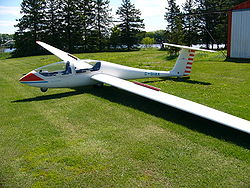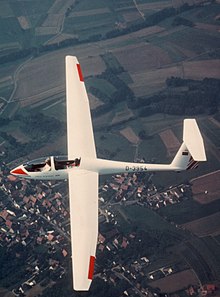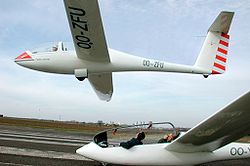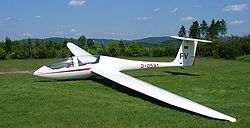Coarse G 103
| Grob G 103 series | |
|---|---|

|
|
| Type: | Glider |
| Design country: | |
| Manufacturer: | |
| First flight: |
December 1976 |
The Grob G 103 is a two-seater glider made by Grob Aircraft AG from Mindelheim , which is mainly used for training and aerobatics training (in the 'Acro' version). The Twin Astir is a further development of the single-seater G 102 . The gliding index is 92.
The glide ratio is 38, the maximum permissible speed (V NE ) is 250 km / h, the maneuvering speed is 170 km / h. The acro versions are fully suitable for aerobatics ; they are therefore approved for load multiples of + 6 / −4 g if additional reinforcements are made to the hull. The standard versions are approved for simple aerobatics ; the maximum load factor is + 5.3 / −2.65 g .
Construction and flight characteristics
The Twin is a two-seater in GRP construction. It has a one-piece trapezoidal wing and T-tail. The connections of all control elements are manual, the control takes place mainly by means of control rods. The two-part hood opens to the side and enables a very good view from the rear seat, as well as easy entry and exit. Unlike most gliders, the wings are not secured with bolts, but with bayonet locks. The wings can also be locked individually.
The Twin is a good-natured glider and can glide very well (compared to "contemporaries"), especially at high speed. Especially with the first models (Twin Astir and partly with the Twin II), however, the steering forces are high, so that quickly circling and centering tight thermals is more strenuous than usual. In the Twin III, on the other hand, the steering forces are similar to those of other two-seaters.
Since the twin cannot spin when flown in two seats, duck wings can be attached for spin exercises.
Versions
The following versions were produced:
- Twin Astir
- Twin Astir trainers
- Twin II
- Twin II Acro
- Twin III
- Twin III Acro
- Twin III 20 m
- Twin III SL
Twin Astir
The Twin Astir was developed as a two-seater counterpart to the Astir and was officially announced at the end of 1975. The first flight of the prototype took place with some delay in December 1976.
It has a retractable landing gear and ballast tanks for cross-country flights. The Twin Astir Trainer was derived from the standard model as an independent series and differs from this essentially in the absence of ballast tanks and the sprung, non-retractable landing gear. Both variants are approved for simple aerobatics and could be converted to a fully aerobatic acro version.
In 2003, investigations into the fuselage structure indicated that " the safeguards against damage to the fuselage under limit loads might not be sufficient ". As a result, the maximum permissible speed was reduced for all variants and the permission for acrobatic flights was revoked for the acro versions. Simple aerobatics could still be performed. A year later, the maximum speed was raised again to 250 km / h, but the aerobatic ban remained.
Twin II
The Twin II is the successor to the Twin Astir. Water ballast has been omitted here; the unsprung, non-retractable main landing gear was placed behind the center of gravity and supplemented by an additional nose wheel.
Twin II Acro
The Twin II Acro is a variant of the Twin II that was designed for aerobatics thanks to additional reinforcements in the structure. For a long time it was a tough competitor of the ASK 21 in the two-seater suitable for aerobatic training . The British Air Force ordered 100 copies of the Twin II Acro and still uses at least some of them today under the name Viking T Mk1 for the Volunteer Gliding Squadrons as training aircraft.
Tests carried out in addition after a longer period of operation and assuming increased "damage tolerances" revealed the need for a torsionally stiffer fuselage tube. Subsequent changes (installation of reinforcements in the fuselage tube) are required in order to regain the full acro approval that has expired after these tests.
Twin III
The Twin III is the further development of the Twin II with a modified trapezoidal wing. The hull is largely the same. The Twin III was produced in a total of 13 copies and, in contrast to the Twin III Acros, has a hull made of carbon fiber reinforced plastic (CFRP / carbon). The Twin III is conditionally suitable for aerobatics (category U). The elevator has a spring trim and is connected automatically. The rudder forces are significantly lower than in the previous models.
Twin III Acro
The Twin III version has a different wing profile than the Twin II with a significantly lower lift coefficient in inverted flight. The Twin III Acro is approved for aerobatics, but due to the high minimum speed in inverted flight, it is not suitable for aerobatic beginner training. Since 2004, the same changes to the fuselage have to be made to restore the aerobatic certification of the Twin III Acro as are necessary for the Twin II Acro. The last copy of the Twin III built has already received the steerable nose wheel of the Twin III SL version, so that handling on the ground is much easier.
Twin III 20 m
The Twin III 20 m is the extended version of the Twin III. The glider is identical to the Twin III, only the span was increased to 20 meters by attaching winglets to the wing tips. This improves the glide ratio from 38 to 41. The Twin III 20 m can also be converted into a Twin III by removing the winglets and replacing them with shorter wing tips.
Twin III SL
From the Twin III , the evolved version of a self-launching two-seater with retractable engine was built, called the Twin III SL . It is equipped with a fold-out Rotax 505A with 43 HP and a controllable pitch propeller. In contrast to the motorless versions of the Twin III, the nose wheel is steerable, which should simplify rolling on the ground.
Technical specifications
| Parameter | TWIN Astir / -Trainer | TWIN II / -Acro | TWIN III / -Acro | TWIN III 20 m |
|---|---|---|---|---|
| span | 17.5 m | 18 m | 20 m | |
| Wing area | 17.8 m² | 17.52 m² | 18.5 m² | |
| Wing extension | 17.1 | 18.5 | 22nd | |
| Wing loading | 36.5 kg / m² | 32.6 kg / m² | 34.3 kg / m² | |
| profile | Eppler 603 | Eppler 583 | ||
| Hull length | 8.1 m | 8.18 m | ||
| Torso height at CPR | 1.6 m | 1.55 m | ||
| Trunk width | 0.71 m | |||
| Cockpit height | 1.02 m | |||
| Empty mass | approx. 400 kg | 370 kg | approx. 370 kg | |
| Max. Takeoff mass | 650 kg | 580 kg | 600 kg | |
| Max. Payload | approx. 250 kg | approx. 210 kg | 230 kg | |
| Glide ratio | 38 at 110 km / h and 650 kg |
36.5 at 95 km / h and 450 kg |
38 at 97 km / h | 41 at 109 km / h |
| Slightest sinking | 0.73 m / s at 90 km / h and 650 kg |
0.64 m / s at 80 km / h and 450 kg |
0.64 m / s at 80 km / h | 0.60 m / s at 70 km / h |
| Stall speed | 63 km / h | |||
| Top speed | 250 km / h | 280 km / h | 250 km / h | |
| Maneuver speed | 170 km / h | 200 km / h | ||
| Maximum speed in aircraft tow |
170 km / h | 185 km / h | 170 km / h | |
| Top speed in winch launch |
120 km / h | 140 km / h | 140 km / h | |
See also
Web links
- Grob Aircraft AG website
- Type certificate Grob Sailplanes - EASA-TCDS-A.250 (PDF; 452 kB)
- Service successor for Grob gliders
- Pictures of Twin I / II / III on www.airliners.net
Individual evidence
- ↑ a b Grob soars into the 80s . In: JM Ramsden (Ed.): FLIGHT international . tape 3708 , no. 117 . IPC Transport Press Ltd., April 12, 1980, ISSN 0015-3710 , p. 1126 ( flightglobal.com [PDF; 1.5 MB ; accessed on July 4, 2010]).
- ↑ LTA No. 2003-231 / 2 (PDF) Luftfahrt-Bundesamt. Archived from the original on May 18, 2004. Retrieved March 8, 2009.
- ↑ LTA No. 2003-231R3 (PDF) Luftfahrt-Bundesamt. Retrieved on March 8, 2009. ( Page no longer available , search in web archives ) Info: The link was automatically marked as defective. Please check the link according to the instructions and then remove this notice.
- ↑ www.sailplanedirectory.com (English) ( Memento of February 14, 2007 in the Internet Archive )
- ↑ 622vgs.org.uk (English) ( Memento from April 15, 2009 in the Internet Archive )
- ↑ www.625vgs.org.uk (English) ( Memento of the original from April 15, 2009 in the Internet Archive ) Info: The archive link was inserted automatically and has not yet been checked. Please check the original and archive link according to the instructions and then remove this notice.
- ↑ a b LTA No. 2004-002 (PDF) Luftfahrt-Bundesamt. Archived from the original on May 18, 2004. Retrieved March 8, 2009.





